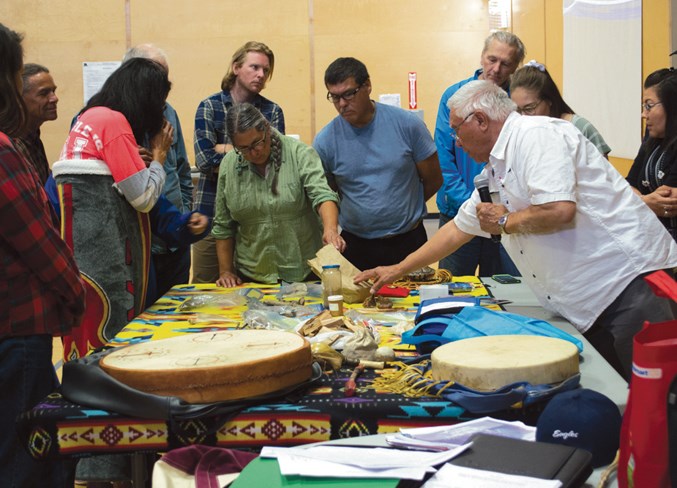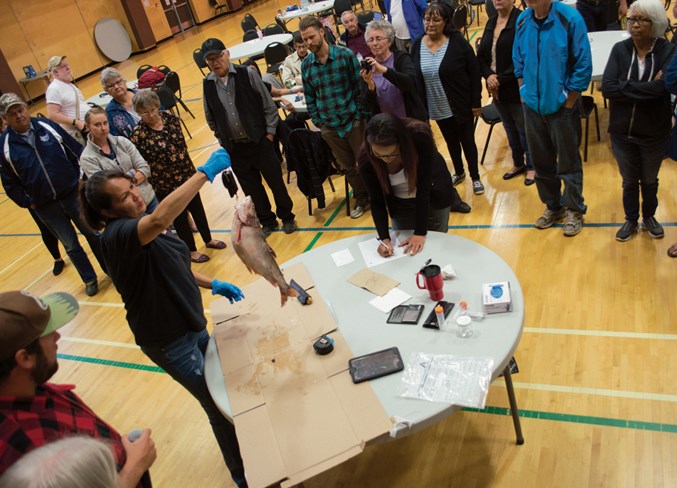About 60 people from all over western Canada met in Wabasca July 18-20 to learn about and discuss land, water and everything in between at the renewed annual gathering of the Keepers of the Water.
Keepers of the Water is comprised of First Nations, Métis, and Inuit peoples; environmental groups; concerned citizens; and communities working to protect the Arctic Drainage Basin. The organization consists of more localized groups like Keepers of the Athabasca and the Keepers of the Peace, which work to protect watershed regions.
Interim executive director of Keepers of the Water Jesse Cardinal said the organization creates dedicated space to talk and learn about water.
“You will learn a lot when you come, no matter who you are,” Cardinal said.
“What what makes these gatherings really nice is when you walk into the gathering, you’re definitely coming to an Indigenous gathering, but it’s open to everybody,” she also said.
Keepers of the Water have been hosting gatherings since 2006 in different communities. Due to staff transitions, 2017 and 2018 gatherings were not held, said Cardinal, who entered her role earlier this September.
“By traveling to different communities we are able to learn and educate,” Cardinal said. “The communities have a lot of knowledge. For example, there are a lot of local community presentations here from Bigstone, but we’ve also brought in people from other communities so everybody gets to learn about other people’s communities, as well.”
Water wasn’t the only thing on the menu. Attendees learned about traditional Indigenous teachings from Bigstone Cree Nation’s Elder Mike Beaver who spoke about medicine. They also took part in a fish scaling and cleaning demonstration at the Kapaskwatinahk cultural grounds, and learned about Indigenous women’s self determination and sovereignty from Athabasca University professor and Bigstone member Josie Auger.
“Often, water becomes the third or fourth or fifth topic on an agenda,” Cardinal said.
After a traditional pipe ceremony and a welcome from Bigstone Cree Nation July 18, the family of Clement Auger — an environmentalist who grew up in Athabasca in the 1950s — also shared his self-documented 2008 water journey.
Presentations
On the last day of the gathering, Athabasca resident Alfred Beaver shared the story of how Bigstone Cree First Nation got its name.
He also spoke about Indigenous and Métis men who used to drag the scows up and down the Athabasca River to Fort McMurray.
“The names of the Indians and the Métis that did the work were never mentioned in history,” he said. “Those are the forgotten men.”
Other presentations included one on a partnership with the University of Victoria regarding corporate mapping project, which Cardinal said she is excited about.
Cardinal said the project is looking at the big industrial projects that are operating in northern Alberta.
“They’re going to provide us the information of all the big water licenses,” she said. “So basically, what we’re going to see is all the big water withdrawals that are happening in northern Alberta, and what companies they’re tied to. And that allows us to share that back with community people.”
Environment monitoring
Speaking July 18, Bigstone Cree First Nation lands department land manager Troy Stuart presented some of the findings of the Bigstone Water Sampling Report.
The report was part of the Wabasca Lake Monitoring Project, “the project originated, in part, from community concerns about general water quality degradation and the health of walleye in the lake,” according to a Government of Alberta website.
“We went out on the lake with the government after someone brought in a deformed fish they caught,” he said. “There was a lot of impact on the lake because of forestry.”
He added that the project had “a lot more Indigenous involvement,” than other government projects.
“It wasn’t just them telling us what they were doing; they showed us how they sample water and took us out (on the lake),” he said.
On July 19, University of Calgary professor and veterinarian Susan Kutz presented on a sampling kit developed for hunters, used to monitor populations non-visible conditions like mercury levels in the liver or kidney and other contaminants in caribou.
“Communities are worried about climate change, oil and gas, and how that affects animals they eat,” she said during the presentation. “And sometimes, they’re not sure if an animal deviance is something they should be concerned about or not.”
She said her team meets with local communities to share the data they collected from animal samples sent from that area.
“We do see a lot more animals in poor conditions,” she said.
The Cold Lake First Nations lands and resources department also demonstrated how they conduct their community-based monitoring of fish in the steam-assisted gravity drainage areas of their community. SAGD is an oil recovery technology for producing heavy crude oil and bitumen. The department is also monitoring water in the area.
“People in our area know there are issues with the fish and the water,” Duane Janvier, summer student for Cold Lake First Nations’ lands and resources department. “The condition of the animals that we eat sparked us to do this monitoring and it’s just the beginning of it.”
“We are tracking data to have a long-term database,” said Findlay MacDermid, Denne Ni Nennè manager for Cold Lake First Nations’ lands and resources department. “We’ve seen an increase of mercury in whitefish … but Cold Lake, compared to the Canadian average actually has less mercury.”
The presentation included a fish monitoring demonstration, where attendees were shown how to cut samples of fish gills, fins, measure organs like the liver and put samples in tubes.
“I see lots of different scientists working on all these different studies, so how do we bring it all together?” Janvier said.
“Anyone in your community can pick this up and do it,” MacDermid added.
 Elder Mike Beaver from Wabasca explains medicinal herbs and items that one can find in local forests and their purposes, including chaga mushroom, rat root and mountain ash.
Elder Mike Beaver from Wabasca explains medicinal herbs and items that one can find in local forests and their purposes, including chaga mushroom, rat root and mountain ash.
Cultural elements
The Keepers assembly included Elders and local community members sharing Cree culture through food, song and presentation.
On the evening on July 18, members of the Bigstone Cree First Nation gave a demonstration to assembly attendees on how to scale and clean fish, then fed the crowd smoked whitefish and fried fish. Rabbit stew and moose heart stew were also on the menu.
A small group of people also butchered a moose, preparing the meat and slicing it to place above a nearby fire on long, thin logs where it was smoked over the course of two days.
On July 19, Bigstone Cree Elder Mike Beaver spoke about his experiences growing up, and how he learned about medicinal and healing plants and other things that can be found in the area. He also spoke about the meanings of different Cree words and passing knowledge down to future generations.
“We are becoming strong, strong people — traditional people,” he said. “And this has to continue. We have to transfer this knowledge, the knowledge that we have gained over the years. And all of you have something to offer, every one of you.”
— Written by Margaryta Ignatenko & Allendria Brunjes



